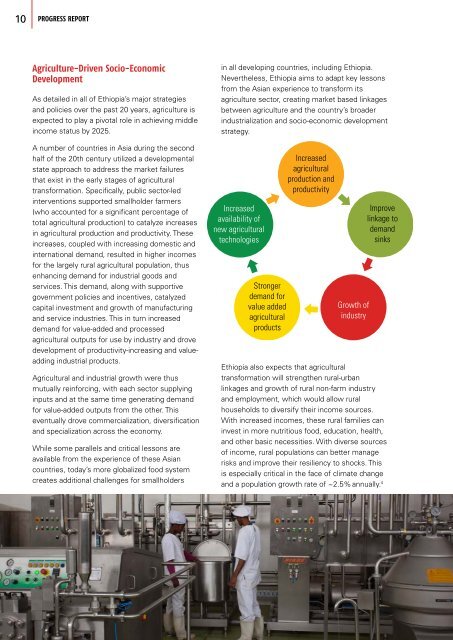PROGRESS REPORT
1LLMfQ4
1LLMfQ4
You also want an ePaper? Increase the reach of your titles
YUMPU automatically turns print PDFs into web optimized ePapers that Google loves.
10 <strong>PROGRESS</strong> <strong>REPORT</strong> TRANSFORMING AGRICULTURE IN ETHIOPIA 11<br />
Agriculture-Driven Socio-Economic<br />
Development<br />
As detailed in all of Ethiopia’s major strategies<br />
and policies over the past 20 years, agriculture is<br />
expected to play a pivotal role in achieving middle<br />
income status by 2025.<br />
A number of countries in Asia during the second<br />
half of the 20th century utilized a developmental<br />
state approach to address the market failures<br />
that exist in the early stages of agricultural<br />
transformation. Specifically, public sector-led<br />
interventions supported smallholder farmers<br />
(who accounted for a significant percentage of<br />
total agricultural production) to catalyze increases<br />
in agricultural production and productivity. These<br />
increases, coupled with increasing domestic and<br />
international demand, resulted in higher incomes<br />
for the largely rural agricultural population, thus<br />
enhancing demand for industrial goods and<br />
services. This demand, along with supportive<br />
government policies and incentives, catalyzed<br />
capital investment and growth of manufacturing<br />
and service industries. This in turn increased<br />
demand for value-added and processed<br />
agricultural outputs for use by industry and drove<br />
development of productivity-increasing and valueadding<br />
industrial products.<br />
Agricultural and industrial growth were thus<br />
mutually reinforcing, with each sector supplying<br />
inputs and at the same time generating demand<br />
for value-added outputs from the other. This<br />
eventually drove commercialization, diversification<br />
and specialization across the economy.<br />
While some parallels and critical lessons are<br />
available from the experience of these Asian<br />
countries, today’s more globalized food system<br />
creates additional challenges for smallholders<br />
in all developing countries, including Ethiopia.<br />
Nevertheless, Ethiopia aims to adapt key lessons<br />
from the Asian experience to transform its<br />
agriculture sector, creating market based linkages<br />
between agriculture and the country’s broader<br />
industrialization and socio-economic development<br />
strategy.<br />
Increased<br />
availability of<br />
new agricultural<br />
technologies<br />
Stronger<br />
demand for<br />
value added<br />
agricultural<br />
products<br />
Increased<br />
agricultural<br />
production and<br />
productivity<br />
Growth of<br />
industry<br />
Improve<br />
linkage to<br />
demand<br />
sinks<br />
Ethiopia also expects that agricultural<br />
transformation will strengthen rural-urban<br />
linkages and growth of rural non-farm industry<br />
and employment, which would allow rural<br />
households to diversify their income sources.<br />
With increased incomes, these rural families can<br />
invest in more nutritious food, education, health,<br />
and other basic necessities. With diverse sources<br />
of income, rural populations can better manage<br />
risks and improve their resiliency to shocks. This<br />
is especially critical in the face of climate change<br />
and a population growth rate of ~2.5% annually. 4<br />
The Current Status of Ethiopia’s Agricultural<br />
Transformation<br />
By nearly all measures, agricultural transformation<br />
in Ethiopia can be considered to be well<br />
underway. This has been characterized by major<br />
public sector investments in order to stimulate<br />
agricultural production and productivity increases,<br />
as well as to develop (and better manage) the<br />
country’s natural resource base and reduce the<br />
vulnerability of farming households.<br />
Ethiopia is one of the few countries in Africa<br />
that has consistently surpassed the CAADP<br />
targets of 6% annual agricultural growth and<br />
10% national public expenditure towards the<br />
agriculture sector. Over the past decade, Ethiopia<br />
committed an average of 14% of its national<br />
budget to agriculture. 5 This investment has been<br />
used to lay strong foundations for the sector<br />
by building effective institutions and structures,<br />
strengthening policies and regulations, and<br />
expanding agricultural services to smallholders.<br />
Average Yield of Major Cereals<br />
In MT per hectare<br />
2.26<br />
Ethiopia’s Progress Since CAADP (2004-2014)<br />
All of these investments have had a significant<br />
impact in accelerating progress towards<br />
enhanced food security – the starting point<br />
for overall agricultural transformation in<br />
Ethiopia – through production and productivity<br />
increases and targeted support to food insecure<br />
households.<br />
However, more work still needs to be done. In<br />
the coming years, Ethiopia aims to solidify the<br />
progress made to date, by continuing to build on<br />
the considerable investments made over the past<br />
decade. In particular, a more concerted effort is<br />
being placed on supporting smallholder farmers<br />
moving from subsistence to commercial, marketfocused<br />
farming. In this regard, interventions<br />
related to aggregation, processing and marketing<br />
are being prioritized. In addition, increased efforts<br />
are necessary to more systematically leverage<br />
and scale-up innovations that are developed by<br />
smallholder farmers themselves and expand<br />
the role of the private sector across the entire<br />
agricultural value chain.<br />
Cereal Production<br />
In Million MT<br />
21.6<br />
95% 109%<br />
1.16<br />
10.3<br />
G.C 2004 2014 G.C 2004<br />
2014<br />
Source: World Bank Data and Central Statistical Agency (CSA) Agricultural Sample Survey, 2004-2014


